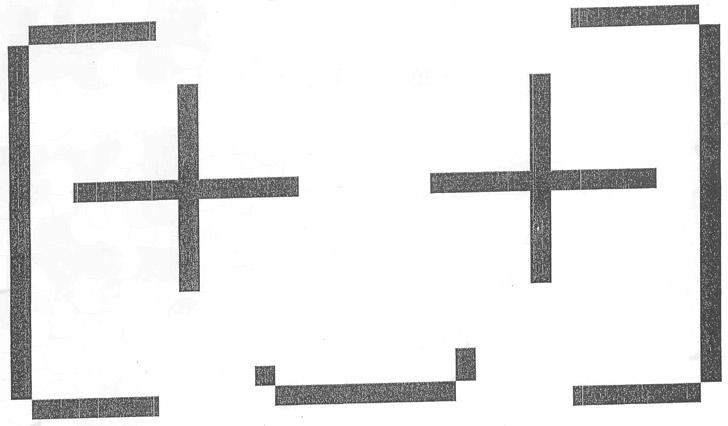Digital Discipline: Minimalism in House and Techno. I
Published in Christoph Cox and Daniel Warner, Audio Culture: Readings In Modern Music, 2004
Like some microbiotic virus, minimalism is everywhere these days. In popular culture and the lifestyle press, it may not have the same cachet it did in the sans-serif ’90s, but from the radio dial to the galleries to underground nightclubs, sonic minimalism is on the upsurge. It’s especially prominent in the various forms of electronic dance music – techno, house – and their “post-techno” offshoots. To paraphrase New Order, the 80s group who themselves thinned pop music down to its lithe, arpeggiated essence, everything’s gone lean.
This, in itself, is not news. The origins of most contemporary electronic dance music — found in Kraftwerk’s 1974 opus “Autobahn” and updated in the late ’80s and early ’90s with the streamlined electronic funk of Detroit techno pioneers like Derrick May and Juan Atkins — emphasized a pared-down palette that cut away all the excesses of a bloating rock and pop tradition.
Since then, much dance-floor fare has restrained itself to a limited set of sounds and has produced forms heavily reliant on loops, recurring sequences, and accumulation-through-repetition. These are key tropes in much pop music, but electronic dance music particularly foregrounds the strategies pioneered in the work of so-called Minimalist composers like Steve Reich and Philip Glass. Indeed, while it’s possible to say that most electronic dance music would be impossible without an emphasis on repetition, beat-oriented electronic music’s most avant-garde productions explore the very nature of repetition itself, carrying on the mantle of classical Minimalism as a movement delving deep into the heart of form – or, perhaps, skittering across its slick surface.
In the late 1970s, rock music produced its own minimalist reaction to inflated, overproduced mainstream rock. The results, No Wave and punk rock, often made explicit links to the ’60s’ drone-minimalism tradition, as with Glenn Branca’s bands Theoretical Girls and The Static, his guitar orchestras, and the many groups that he influenced. But minimalism in rock – from Sonic Youth to Swans to James Chance – adopted a particularly expressivist stance, marked by noisy outbursts, microtonal experimentation, and a stripped-down, visceral sound, at odds with electronic minimalism’s more introspective mechanics. Minimalism also fit rock’s functionalist requirements: punk rock’s three-chord template, which drew from the blues tradition but ran itself through minimalism’s compression engine, guaranteed that its sound could be faithfully replicated by self-taught teenagers playing in basements and VFW halls from Schenectady to San Diego.
Minimalism also satisfied the functionalist requirements of early electronic dance music, which – evolving out of and automating the long, manual mixes pioneered by underground disco DJs like Larry Levan – subsumed all elements to the regulated, mechanized beat. As DJ culture begat an entire cottage industry of recordings intended solely or primarily for mixing, dance tracks came to be understood as representative of a willfully incomplete form; they came into their own only when paired with other tracks. Minimalism’s reliance upon rhythmic and melodic “building blocks” – imagine isolating any single phrase of an early Reich composition, for example – proved the perfect fit for this combinatory form. As techno produced various offshoots, each one emphasizing a particular stylistic tendency, certain substrains focused on this combinatory approach to an almost exaggerated degree.

Indeed, with their strictly codified breakdowns and buildups, records like these are often rightly described as “DJ tools,” something like Lego bricks for the selector’s toybox.
Today it’s impossible to hear Steve Reich’s early tape works “Come Out” and “It’s Gonna Rain” and not hear the roots – however accidental – of contemporary techno. The dubbed-out effects as “Come Out” doubles over upon itself, the way that “It’s Gonna Rain” breaks down its exposition into a tightly looped 4/4 sequence which itself breaks into smaller and smaller repeating pieces (from “It’s gon’ rain/ it’s gon’ rain/ it’s gon’ rain/ it’s gon’ rain” to “it’s gon’/ it’s gon’/ it’s gon’/ it’s gon'” to “rain/ rain/ rain/ rain”) – all of these are key strategies of contemporary dance music.
–
Steve Reich – It’s gonna rain
Steve Reich – Come out
–
Indeed, vocal tracks like Blackman’s 1993 Chicago house tune “I Beat that Bitch with a Bat” cop exactly the same strategy that Reich used to uncover musical rhythms in speech on “Come Out.” (It’s ironic that the strategy Reich used to progressive political ends – the speaker of “Come Out” is a young black man recounting political violence – is here appropriated to misogynistic ends, the tracks’ debatable camp value not withstanding.) If the originators of house and techno were unaware of Reich when they first began sampling and programming their tightly looped progressions, the definitive link was made retroactively when The Orb sampled “Electric Counterpoint” for the club hit “Little Fluffy Clouds” in 1990.
–
Steve Reich – Electric Counterpoint
The Orb – Little Fluffy Clouds
–
None of this is to suggest that Reich and his contemporaries set out to author the fake book for multiple, amateurist musical traditions.
(to be continued)
Posted in academia on October 3rd, 2008 by de-dans | 5 Comments






 gmail
gmail com
com
